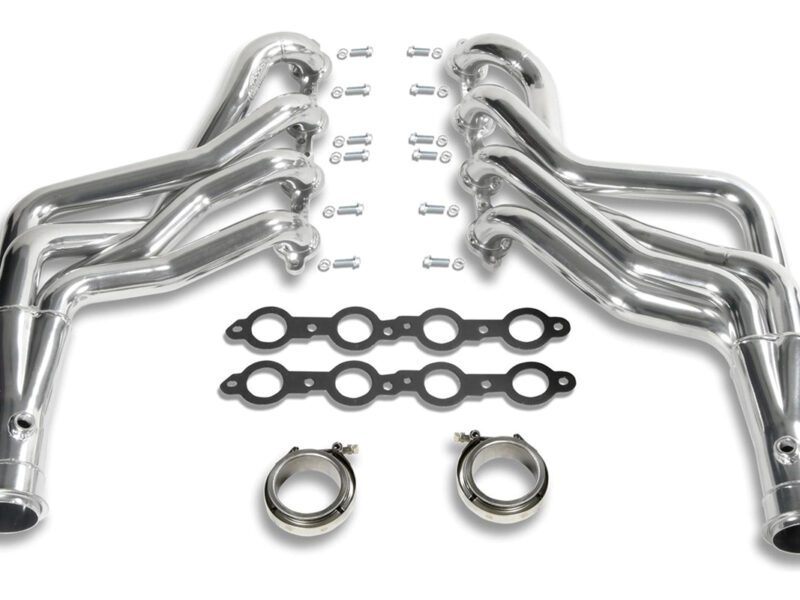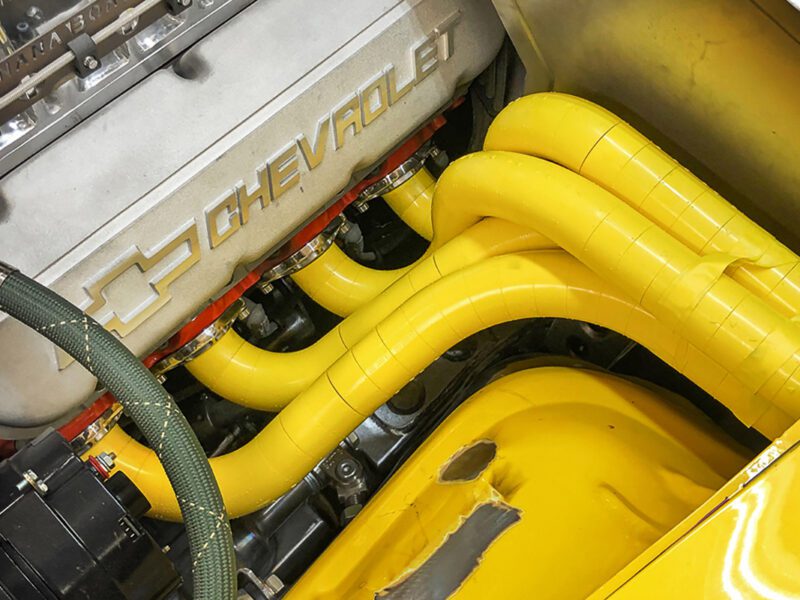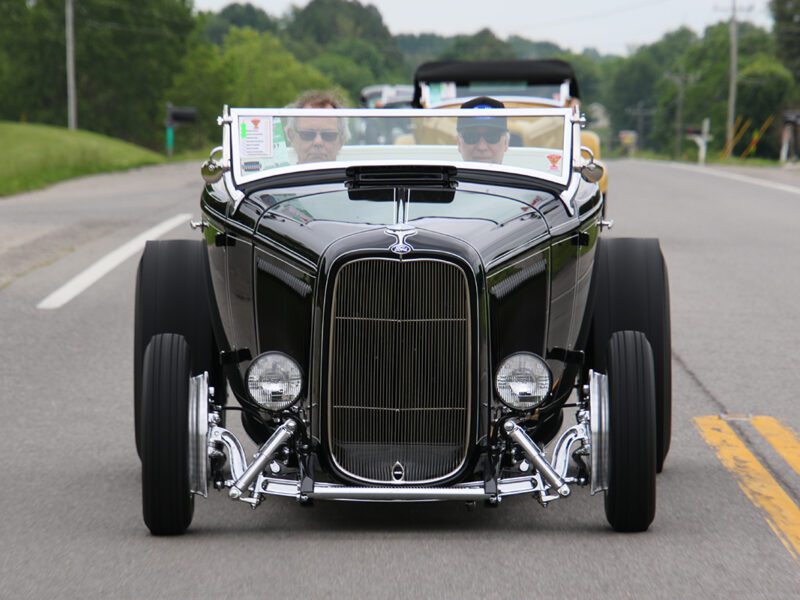Celebrating the Time-Honored Carburetor with a Look at New Offerings and a Refresher Course on Tuning Tips
Judging by the number of ads, tech articles, and feature cars that you read about with electronic fuel injection, you could easily get the feeling that the classic carburetor is obsolete and has been replaced. The truth, however, is that the venerable carburetor is alive and still fueling thousands of fuel hungry hot rod and classic car engines.
In fact, Edelbrock recently introduced an all-new performance carburetor, the VRS-4150, to complement their line of proven AVS carbs. Sure, EFI has taken up considerable space in the fuel delivery sandbox, but we learned that carburetor sales, and continued R&D, are still going strong.
These days, people expect their classic cars to start and idle like their newer daily drivers, which drives a lot of rodders to EFI systems. However, any carb company will explain that a well-tuned carb can achieve the same quick starts, smooth idle, and drivability as EFI. A couple manufacturers we spoke with felt that the choice between a carb or EFI really come down to three things: cost, simplicity, and application.
EFI systems have come down in price and their ease of tuning is getting simpler, but when you add up the amount of work and ancillary components needed to do the installation correctly, EFI adds up. All of a sudden, there’s an electric fuel pump, regulator, high-pressure hose, a number of fittings, and more. Not only did the cost go up significantly, but the system isn’t that simple anymore.
A good carb is still going to cost a few hundred bucks, plus there will be a couple items like the correct trans linkage or a braided line with a filter to the fuel pump, but that’s about it. If you like simplicity, it’s tough to beat a carb. And to get it tuned properly, you’ll spend some time under the hood with a screwdriver instead of sitting behind the wheel adjusting similar settings from a screen.
We found that what you’re building plays a major role in the purchase of a carb or EFI. Traditional hot rods and restorations obviously lean toward carbs for the right look, while pro-touring and restomods often go with EFI.
We’re not here to settle the dilemma about carbs versus EFI, but wanted to give the carburetor a little spotlight this month by showcasing some current offerings, resources, and some refresher tips on installation and tuning. There are still plenty of great choices of new carbs to fuel your cruiser – with the drivability and performance you expect.
Edelbrock VRS-4150 Carb
 New Performer
New Performer
It was quite a surprise to learn about Edelbrock’s all new VRS-4150 performance carburetor. After all, we’re used to seeing superchargers, late-model intakes, and EFI systems roll out from the R&D center of the big E. They’re no stranger to carbs with their well proven Performer series and AVS model, which recently went through a revision as well, but a new performance/racing carb from the ground up was cool to learn about.
When you look closer at the VRS, the performance details emerge. The float bowls carry 20-percent more fuel and feature internal ribs combined with a sculpted baffle and unique float shape to control fuel slosh and ensure uninterrupted fuel flow. The idle circuit features interchangeable discharge jets in each corner, allowing for a smooth, clean idle even when used with a lumpy, low-vacuum camshaft. The intermediate fuel circuits are adjustable to help tune throttle response and for greater control at high RPM, the high speed/main fuel circuit is split into two bleed circuits – one each for the lower and upper sections.
Built to be street friendly, but race ready, the VRS is available in 650, 750, 850 and 950 cfm models to fit all 4150 and 4500 flange manifolds.
 JET Performance Products
JET Performance Products
Q-Jet by JET
The Rochester Quadrajet, unveiled on Chevy’s introduction of the 396c.i. big block, is the Rodney Dangerfield of muscle car carbs…it just never got much respect. Remember, though, it was never meant to be a race carb. Its unique small-diameter primaries and bigger secondaries (earning its ‘spreadbore’ moniker) have powered many factory muscle cars and cruisers for years with terrific idle and low-speed drivability combined with plenty of fuel at WOT!
JET Performance Products understands the capabilities of the vintage Q-Jet and can restore or custom build a carb for your engine. They’ll go through the entire carb from top to bottom and even bring back that recognizable color for a perfect restoration. Each carb will be recalibrated and tuned to the specific application with an accelerator pump and the high-speed circuits tuned accordingly. JET offers a number of rebuild stages for Quadrajets to support a stock rebuild or a higher horsepower engine.
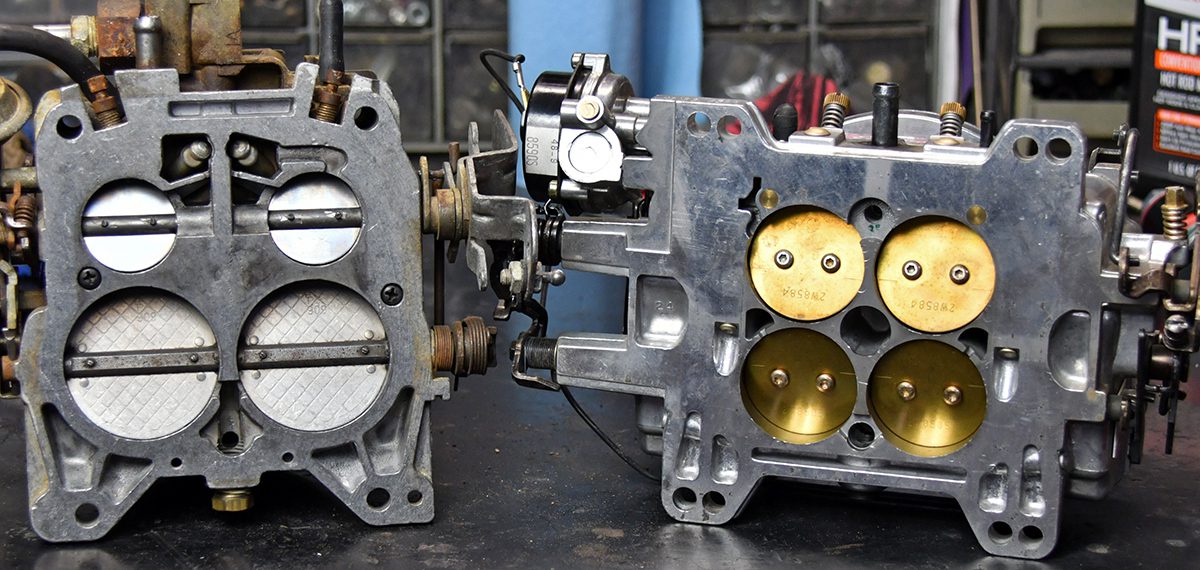
You may hear the terms spread-bore or square-bore carbs. The Quadrajet on the left, with its smaller primaries and huge secondaries, is known as a spread-bore while the square-bore on the right has equal sized throttle bores.
Hot Rod Carbs
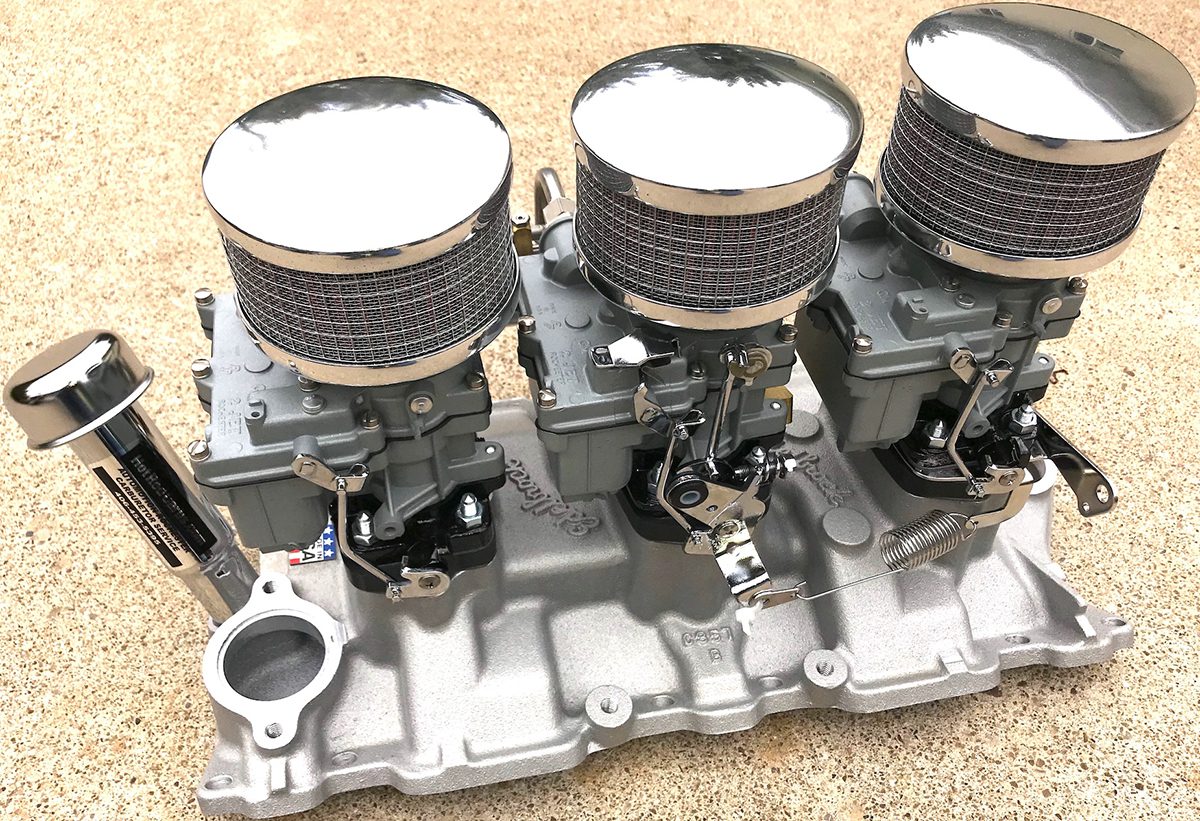 A Tuned Trio
A Tuned Trio
When it comes to making your hot rod really look the part, you can’t beat a custom built Three-Deuce Carburetor System. And when it comes to rebuilding your small base Rochester 2-jet carbs, or to have a carb system custom built for your application, you’d be wise to reach out to Hot Rod Carbs.
With over 45 years of Rochester carburetor experience, Automotion Rochester Carburetor Service (better known as Hot Rod Carbs), has the technical experience, the knowledge of function, and the correct parts for these classic carbs. If you just need the right parts to rebuild your own carburetors, or if you’d like to order a complete custom-built 3×2 system, with nearly 30 different applications available, HotRodCarbs.com is your one-stop source.
 Summit Racing Equipment
Summit Racing Equipment
Stealth 600
Summit Racing Equipment now offers their popular 600cfm M2008 carburetor in a trick black finish to deliver a stealthy, sleeper look under the hood. The one-piece, all-aluminum design is lightweight and features vacuum secondaries for a smooth transition when the pedal is dropped.
To ease cool morning starts there is an electric choke and for tuning, there are interchangeable discharge nozzles and idle circuit along with center-hung floats that are externally adjustable. A 30cc accelerator pump is installed and for the best atomization, annular discharge boosters are used. The carb is wet flow tested before being shipped so you know it’s ready to go, right out of the box. As usual, Summit thinks things through and includes a chrome-plated steel fuel line, base gaskets, and hardware to make installation a breeze.
Speedway Motors
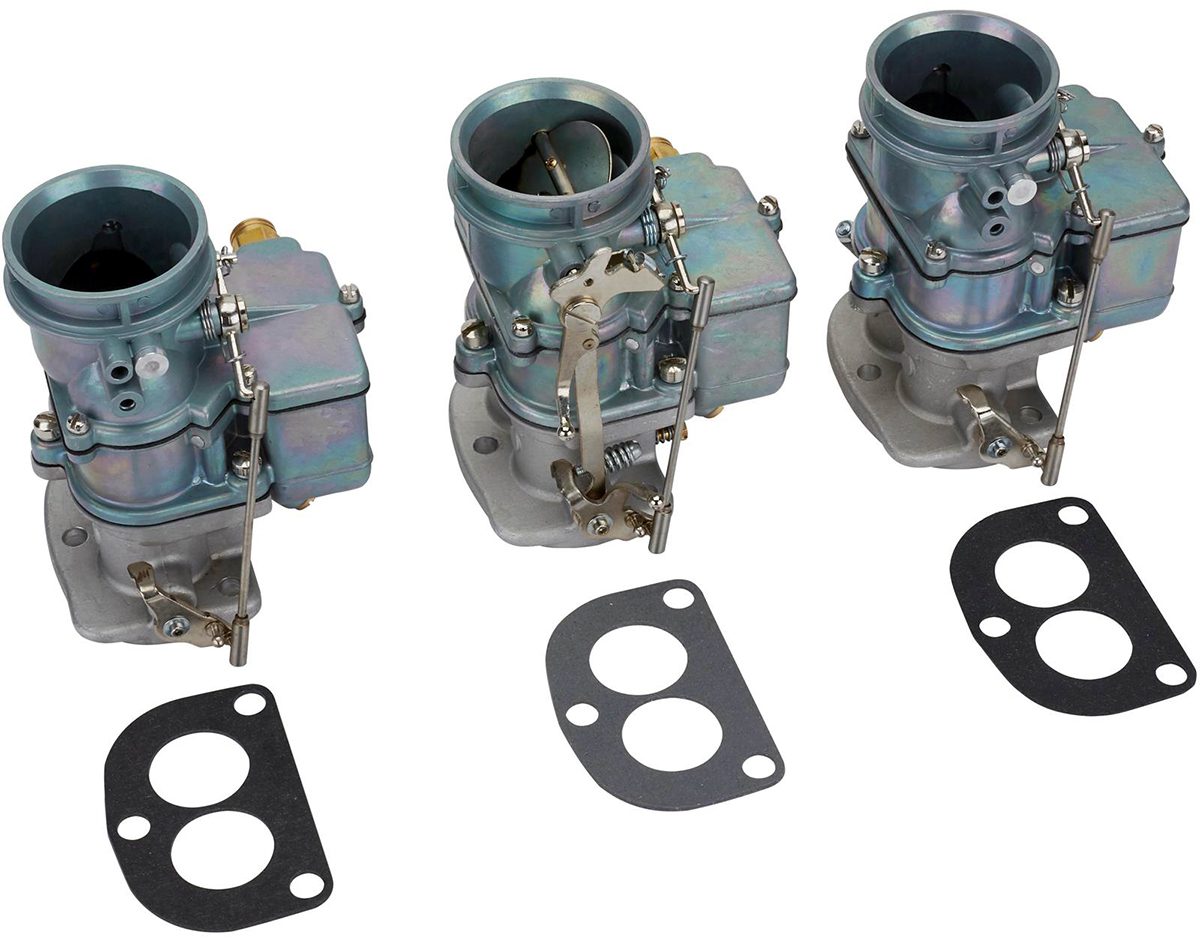 Three-Bolt Twos
Three-Bolt Twos
With their vintage styling and updated performance features, the 9-Super-7 carbs from Speedway Motors are a solid choice to build a classic hot rod 3×2 induction setup. This trio of carbs includes a primary (middle) carb that is flanked by the secondary carbs that come to life with more throttle.
The carbs feature all-new parts including an aluminum base to run cooler than the original cast iron material. To handle today’s fuel blends, a nitrophyl float is used, which is fed through a Grose-style fuel inlet which is much more reliable than the original needle design. For tuning ease, the 9-Super-7 carbs accept original-style jets and other components, plus have an extended brass through shaft to ease linkage connections.
 Holley
Holley
Race Ready
Building a little more horsepower to use on the street and strip? Holley’s HP carbs have been the standard in racing for nearly two decades, but there is always room for improvement! They now offer an all-aluminum model that saves weight while delivering the same performance racers have come to rely on.
HP carbs are available from 390-1000cfm and feature a contoured venturi inlet for balanced air flow, screw-in air bleeds for precision tuning capabilities, high-flow metering blocks, and Dominator-style fuel bowls which allow plumbing from either side for ease of installation. The carbs also have four-corner idle circuits and dual 30cc accelerator pumps for increased fuel delivery upon initial acceleration. For a race-ready carb right out of the box, check out the Holley HP!
Quick Fuel Technologies
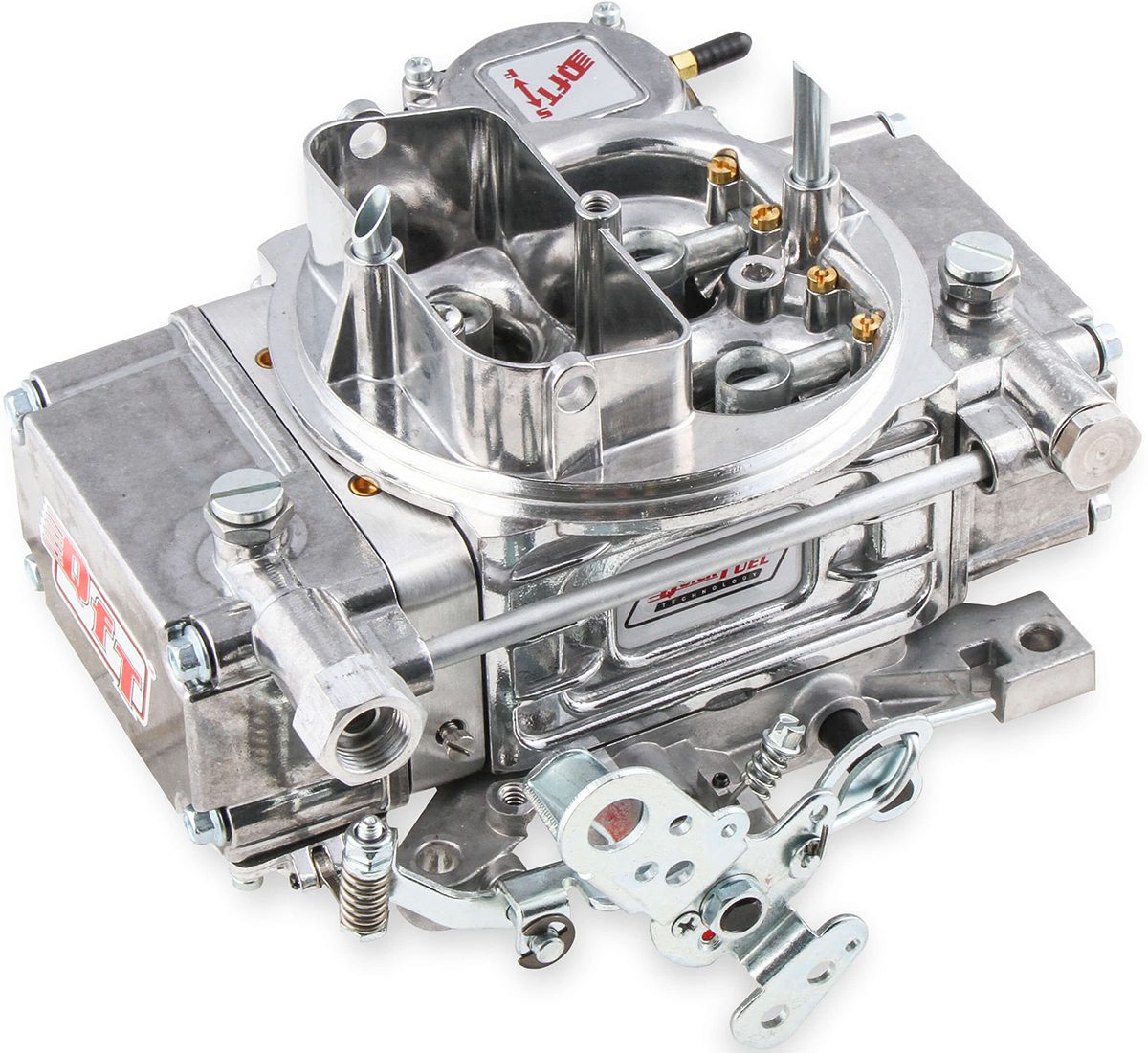 Tunnel Ram Carbs
Tunnel Ram Carbs
Looking for a set of carbs to top your tunnel ram or 2×4 setup? Quick Fuel Technologies has developed a matched carburetor pair based on their 450 Slayer series that are ideal for your tunnel-ram-fed engine. The Slayer Series street carburetors are designed with many of the same innovations that are built into all of QFT’s race-winning carburetors, including changeable air bleeds and power valve channel restrictions, a secondary metering plate with changeable jets, and all-aluminum components for additional weight savings.
All Slayer Series carbs are equipped with universal throttle levers to accommodate a Ford A/T kickdown or GM 700-R4 transmission and have the ability to mount brackets for Chrysler vehicles. The Slayer Series are available in 450, 600, and 750cfm vacuum secondary models.
www.holley.com/brands/quick_fuel/
 Demon Carburetion
Demon Carburetion
Screamin’ 750
Demon Carburetion set out to deliver improved drivability combined with seat-of-the-pants performance wrapped up in an affordable package. Their Screamin’ Demon series, designed with the weekend racer in mind, is the latest development in their evolving family of Race Demon performance carburetors.
The carbs are available in 650-850cfm with mechanical secondaries, as well as a 750cfm vacuum secondary model. They feature lightweight die-cast aluminum construction, large-capacity fuel bowls with dual sight glasses, dual-threaded inlets on each side, and internal baffling to prevent fuel slosh when you are on the track. Engineered and calibrated for street and track performance, the Screamin’ Demons provide four-corner idle adjustments with changeable idle and high-speed air bleeds for precise tuning.
The Carb Shop
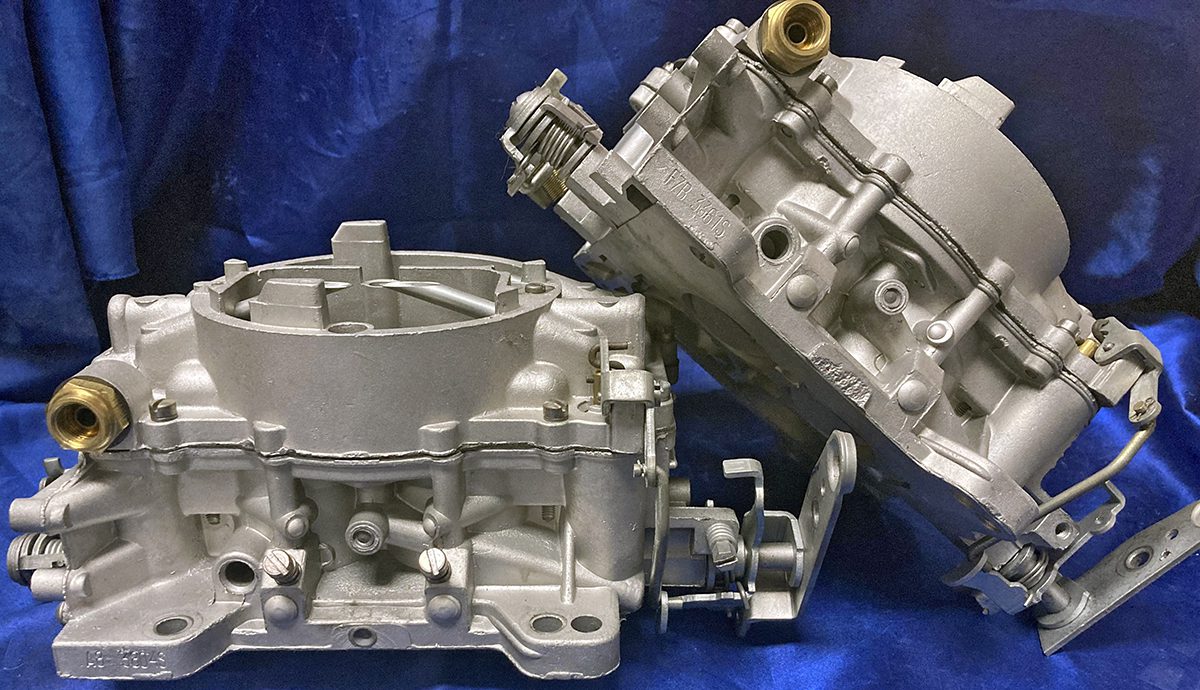 Duals
Duals
There’s just something about the look and performance of a factory 2×4 setup such as the pair of AFBs perched atop a 409 from the early-’60s. One shop that is extremely familiar with the Carter AFB dual quad system, and most any other carb actually, is The Carb Shop. The business has been around since the launch of the big block Chevy, so they’ve been there and done that when it comes to fueling classics and race engines through the decades.
As for the AFB, whether it’s a single carb or a factory-matched dual quad setup, their goal is find a perfect combination of both power and drivability. The carbs will be restored to factory appearance but tuned to your specific application and setup to handle today’s fuel blends. Holleys, Quadrajets, Autolites and more, The Carb Shop will restore, rebuild and retune your carb to match your performance goals.
Carb Tech & Tips
So, you have a new carb sitting on the workbench and cleared some time to get it installed. We gathered a few tips to consider before, during and after installing the carb. The best step, and most often overlooked, is to read the instruction manual!
Got Everything?
Before you even get started, make sure you have everything to finish the job. Most carbs do not come with every single piece of linkage or fitting for your specific application, simply because there are far too many combinations out there. Check to see if you have a manifold gasket. Do you need a fuel line or vacuum line fitting? Will the existing fuel line fit or is the fuel inlet in a different position? The most common missing piece is likely something having to do with linkage for the throttle or the transmission kickdown.
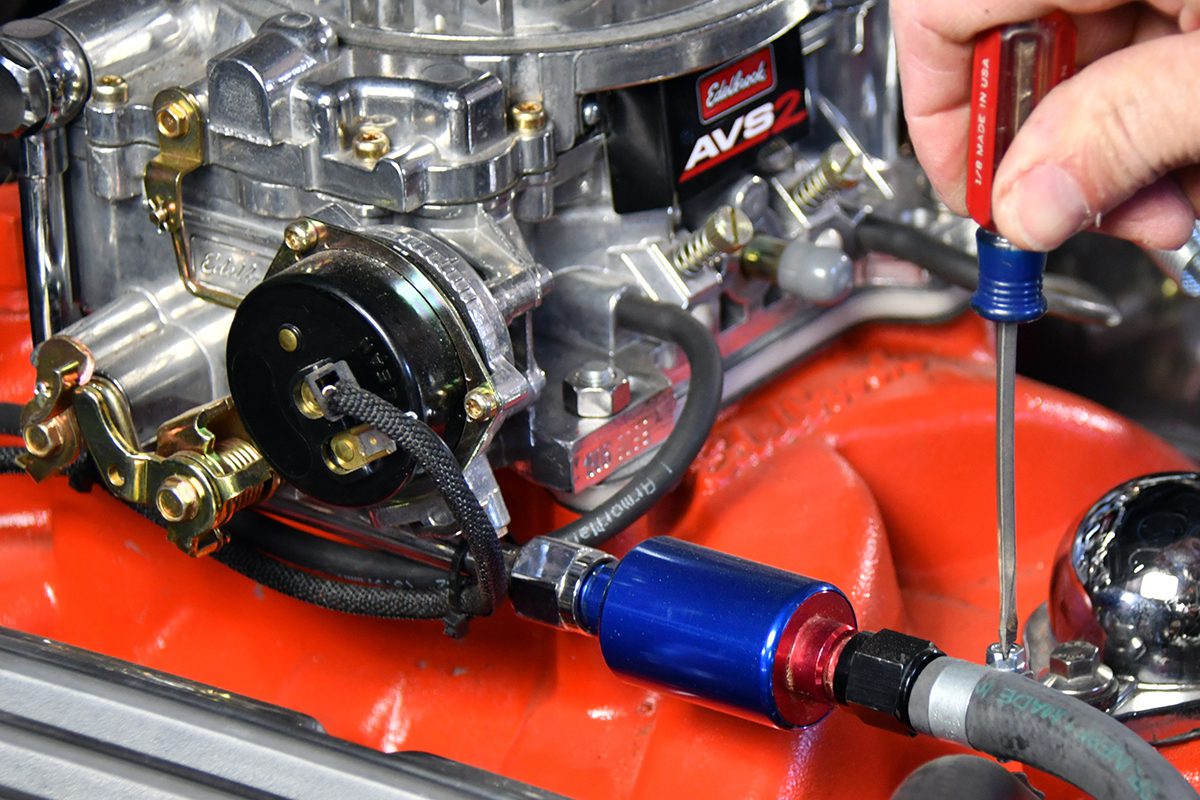
Before getting started installing your new carb, do you have everything such as a fuel filter, new hose clamps and fittings to connect the fuel line?
It is imperative to have the correct transmission linkage or adapter. A common example is when using a GM 700-R4 or 200-4R. If you do not have the proper linkage for the TV cable (Throttle Valve), the trans could be damaged.
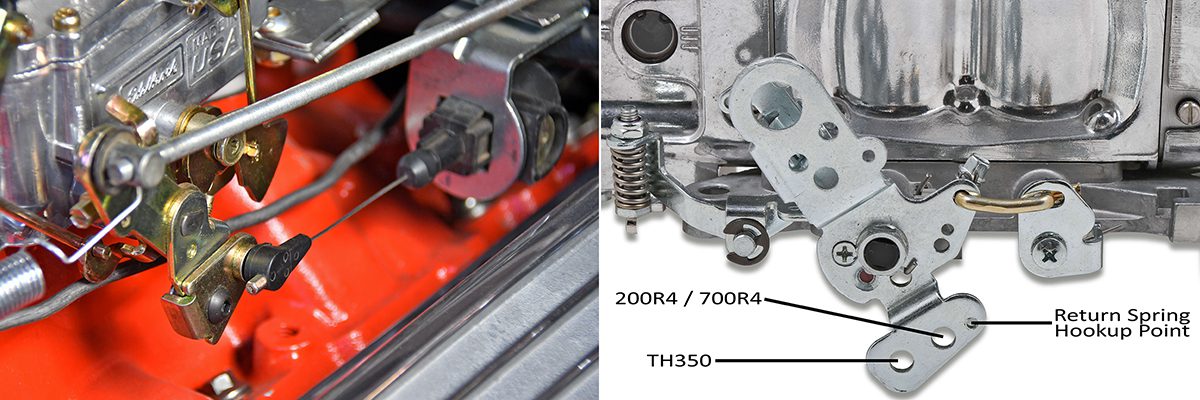
Make sure your carburetor’s linkage has the right connection for your automatic transmission’s kickdown or TV cable. If the geometry for the trans linkage is incorrect, you will have shifting issues or even damage the transmission. The Edelbrock AVS 2 pic (left) shows the right adapter for a 200-4R (PN 8026) while the Demon linkage shows different positions for the cable.
Vacuum Ports
Most carbs have multiple vacuum line ports to use for the transmission, the vacuum advance of a distributor, EGR, cruise control, and other items. The tricky part is that there are two kinds of vacuum sources: ported or manifold vacuum.
Manifold vacuum ports are placed below the throttle plates and basically provide vacuum constantly (of course not during acceleration). Brake boosters and some transmission vacuum modulators will connect to manifold vacuum sources.
Ported vacuum ports are above the throttle blades so there is only vacuum when the throttle is opened. These ports are used for the vacuum advance on distributors, EGR systems and other components that do not require vacuum at idle and closed throttle.
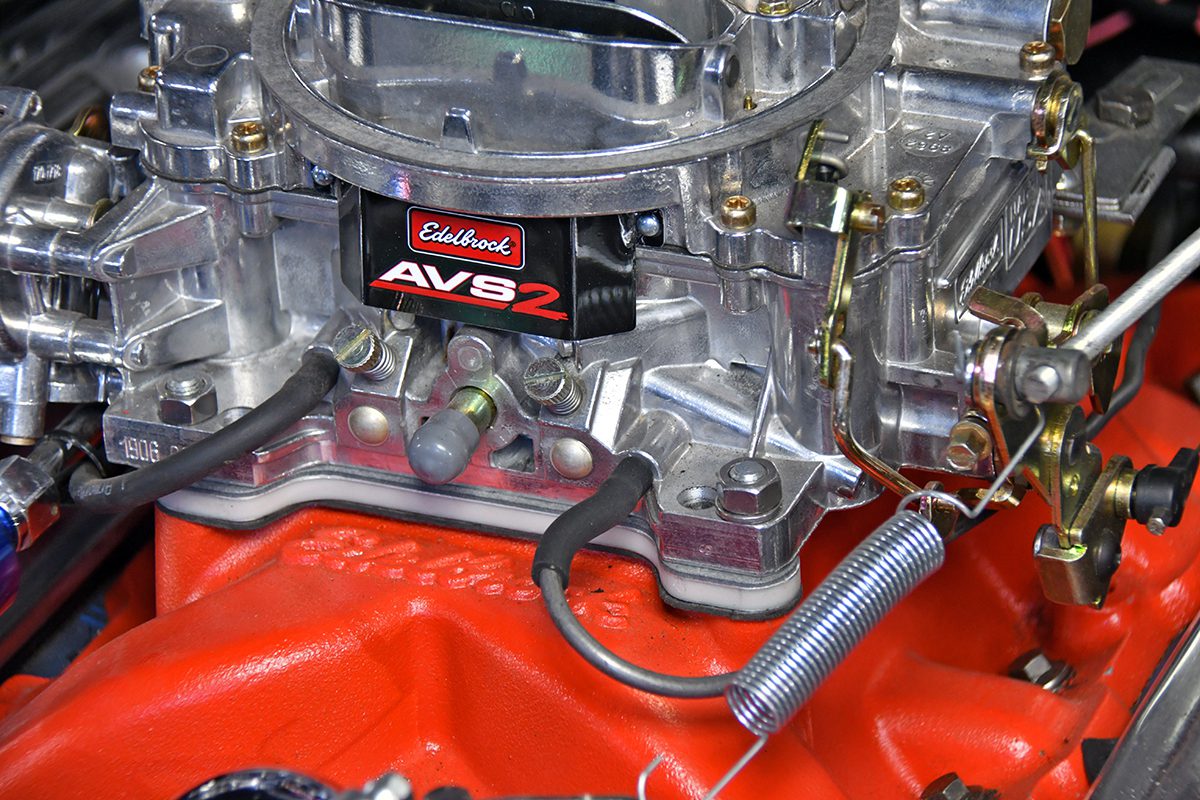
Be sure to confirm the location of ported and manifold vacuum sources on your new carburetor. On this Edelbrock AVS carb, the outlet on the passenger side is ported and connected to the vacuum canister of the distributor. The middle is meant for a PCV and outlet on the driver’s side is manifold vacuum (connected to the transmission).
Initial Startup
Before cranking the engine, do another sweep around the fuel line connections, linkage, vacuum connections (and plugs if not used), and return spring. Once you start cranking the engine over it will likely take a few tries to get fuel to the carb and fill the bowls, so exercise patience and there’s no need to pump the throttle over and over. You need to be mindful of flooding the engine on the initial startup.
Once the engine fires up, the choke will be closed, and you can adjust the idle screw on the linkage to be a little higher while keeping your eyes out for fuel or vacuum leaks. As the engine warms and the choke backs off, you’ll be able to lower the idle speed to a lower rpm and prepare to adjust the idle mixture screws. These screws set the amount of air that feeds in with the fuel at idle and are important to getting a clean, smooth idle. Most street carbs will have two screws while some performance carbs will have four corner mixture capabilities.
As a rule of thumb, you want to set the idle mixture screws to the point where the highest rpm is reached. If you have a vacuum gauge connected to manifold vacuum, the goal is to reach the highest vacuum point. In most cases, turning the screws clockwise leans the mixture while counter-clockwise richens the mix. A good starting point is to turn the screws all the way in, then back each one out about one and a half turns. Start the engine and set the idle speed at your target rpm.
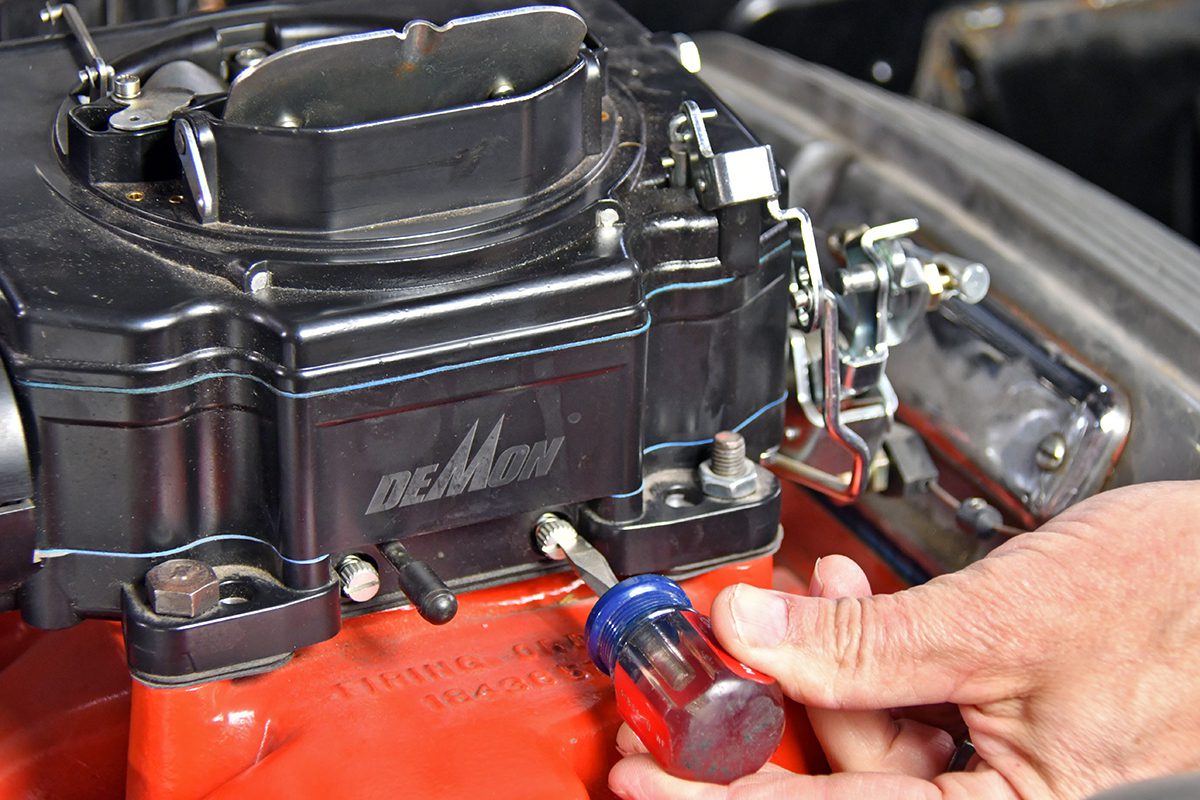
Setting the idle mixture screws is important in obtaining a smooth idle speed as well as the ideal mixture – meaning not overly rich.
Next, adjust one of the idle mixture screws until the highest rpm is reached followed by the other mixture screw. Once set, you’ll likely need to reset the idle speed screw on the linkage. It will take a couple attempts to get the idle exactly where you want it. For automatics, it’s best to have someone sitting in the car with it idling in park.
Another tuning aspect to keep in mind is the initial ignition timing at idle. With today’s fuel blends, you can likely dial in a couple more degrees of timing at idle, however, you may need to retard a couple degrees of total timing to avoid pre-ignition. There’s another few pages we could write about timing, but the point in tuning the idle (and carb) correctly, the ignition timing must be set properly as well.
Test Drive
Before heading out on the open road, make one last visual check for fuel leaks. You’ll want to confirm that the engine settles back to an idle and note the transition from stopped to light acceleration. Are there any hesitations or stumbles? Also, make sure the transmission shifts, including downshifts as you try the secondaries and listen for spark knock or detonation, a sign of too lean (or overly advanced timing). If there’s a rich fuel smell at cruising, you may need to make some other internal carb adjustments.

Next Steps
This really just scratches the surface of tuning a carb. For most cruisers and road warriors, the initial setup and idle quality are important and get you heading in the right direction. Depending on your application and performance goals, you might be set with a choke adjustment or tweaking the accelerator pump action to remove a hesitation or stumble.
Jetting, of course, is key in overall cruising and will need to be looked at as elevation changes. (A rule of thumb is that you need to go 2-percent leaner for every 1,500 feet.) Or perhaps the opening rate of the secondaries, especially on vacuum operated models, could use adjustment.
Another common adjustment has to do with the power enrichment circuit. This circuit is responsible for richening the fuel mixture under heavy loads or acceleration. Holley offers a number of different power valves to change the time the valve opens to allow more fuel. The nozzles where the fuel is delivered in the throttle bore can also be changed on some carbs to alter the amount of fuel and rate delivered.
As you can see, there are many things you can tune-in when it comes to carburetors, depending on the manufacturer and model. All of these settings will be outlined your carb’s instruction manual and some manufacturers have useful videos to show more detailed procedures. It can be a fun exercise and learning experience to take some time to tweak, test, and tune – with the reward of ideal acceleration and drivability.
Tuning Tools

A little modern tech, such as an air/fuel ratio gauge or meter, can help you get your carb really setup to perform. This example from Holley comes with a gauge, harness and O2 sensor to give real-time data about the air/fuel mixture.
Two of the most important tools for setting up your carb are a tach and vacuum gauge. Measuring engine vacuum will help you in setting the idle air/fuel mixture as well as determining the correct power valve, while a tach assists in getting the idle speed set precisely. Remember that the ignition timing is important in getting the idle and performance of a carb dialed in, so a timing light is also something to have on hand during your carb swap.
One modern tool that can be very helpful in tuning a carb is an air/fuel ratio gauge. Like an EFI system, an air/fuel ratio gauge depends on an oxygen sensor to measure the ratio of air and fuel in the exhaust. From here, you can directly see when the engine is rich or lean, and then tune accordingly. Many different gauges and meters are available for a little more modern take on tuning in your carb.


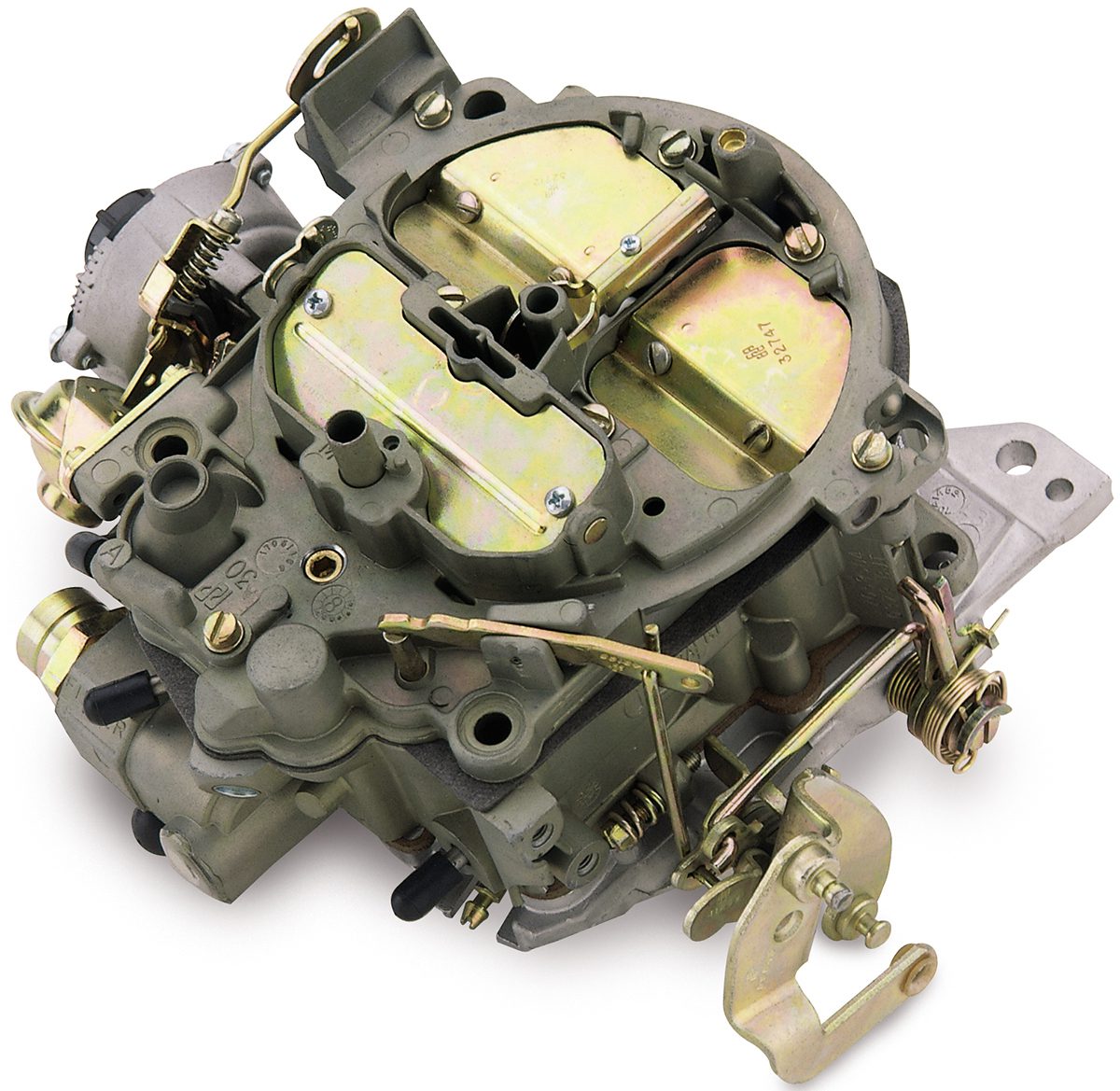 JET Performance Products
JET Performance Products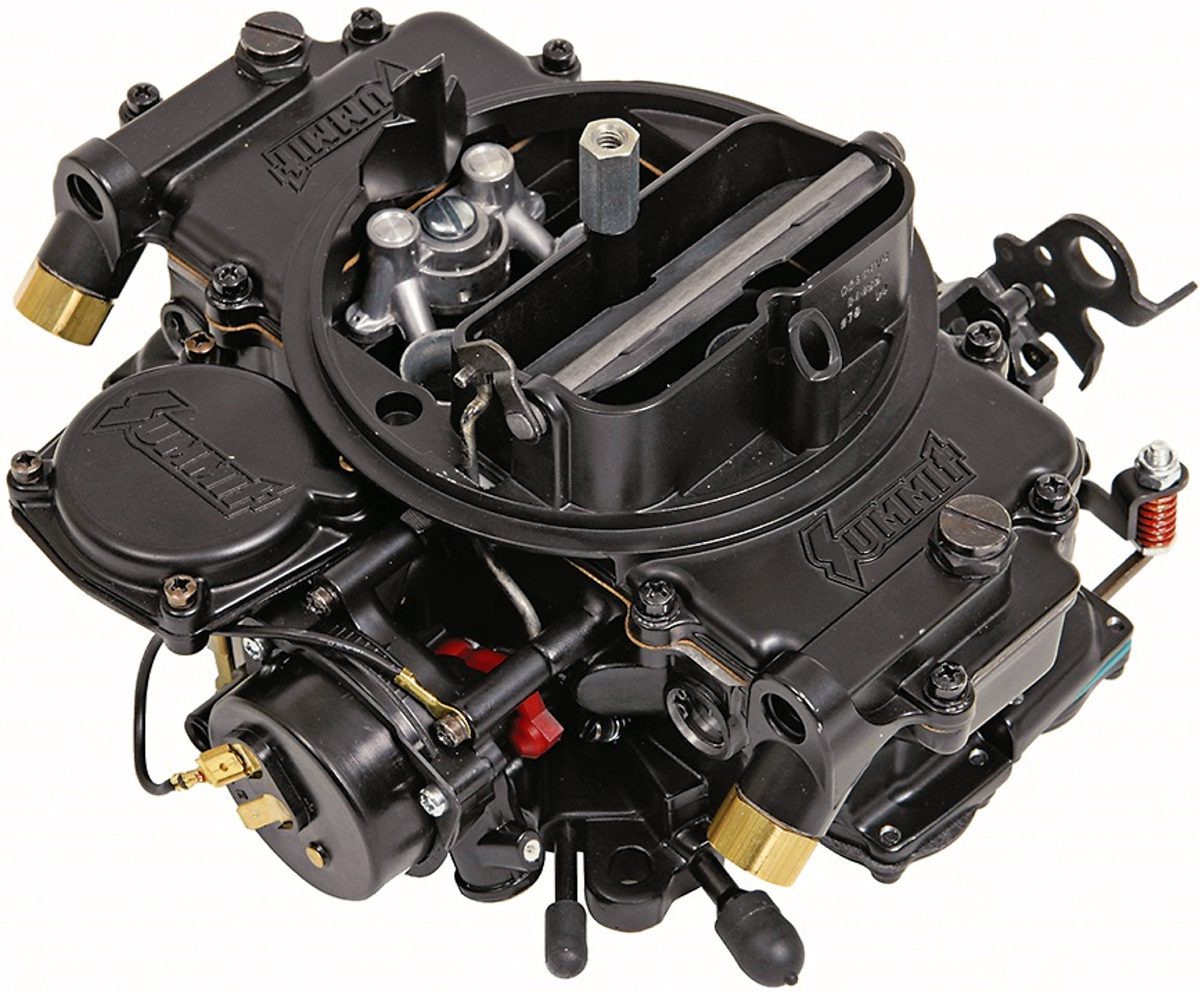 Summit Racing Equipment
Summit Racing Equipment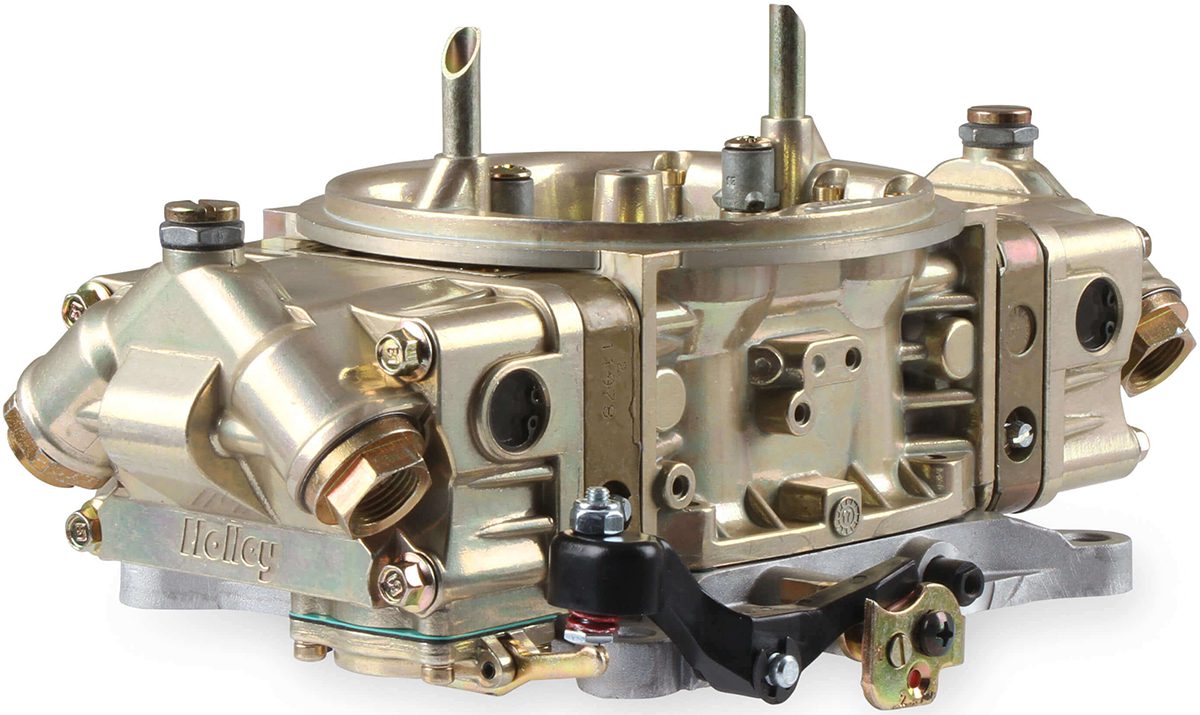 Holley
Holley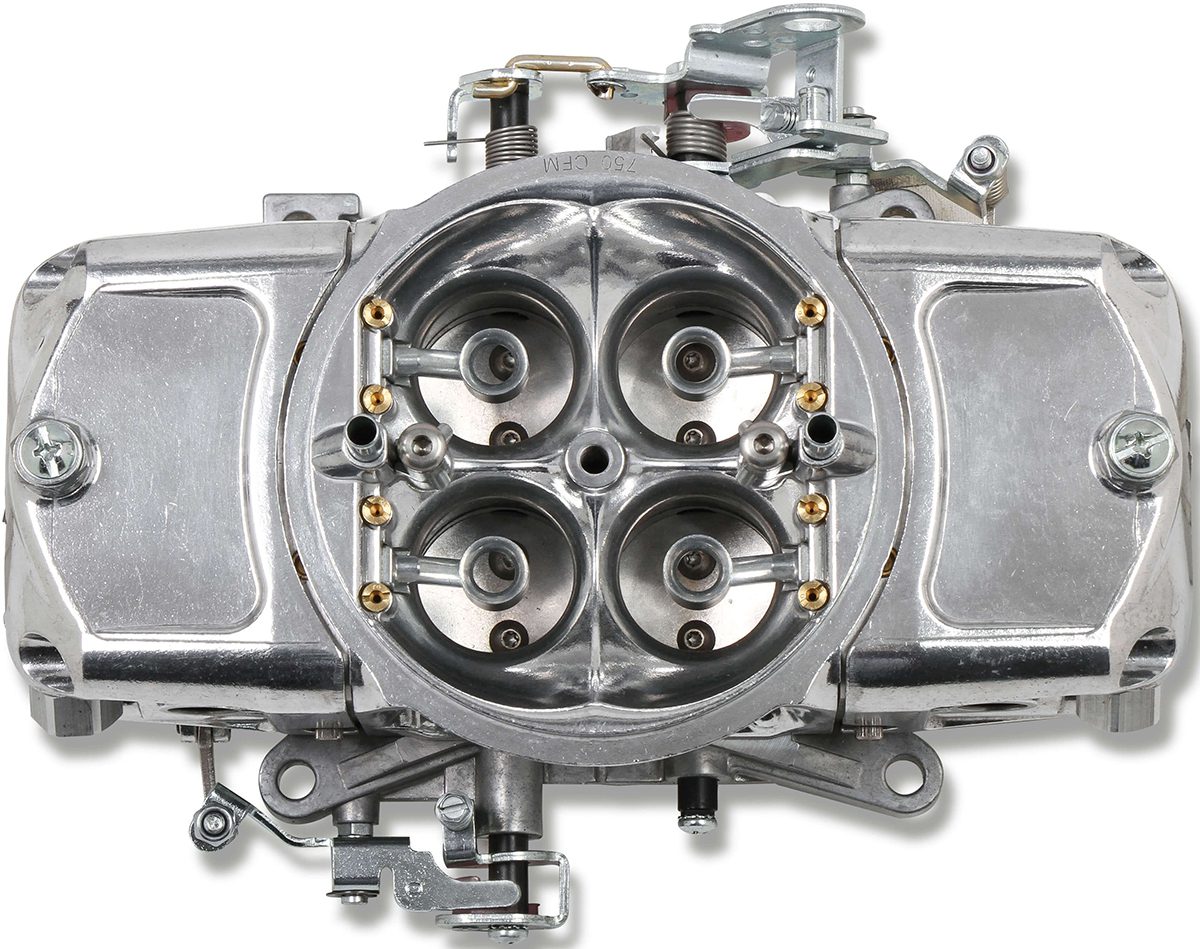 Demon Carburetion
Demon Carburetion
